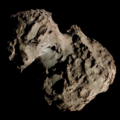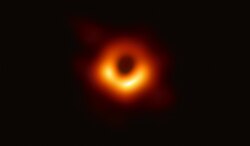 Comet Iwamoto photographed by Brandon Ghany on 26 February 2019 | |
| Discovery [1] [2] | |
|---|---|
| Discovered by | Masayuki Iwamoto |
| Discovery site | Awa, Tokushima, Japan |
| Discovery date | 18 December 2018 |
| Designations | |
| CK18Y010 | |
| Orbital characteristics [3] | |
| Epoch | 3 March 2019 (JD 2458545.5) |
| Observation arc | 348 days |
| Number of observations | 2,771 |
| Aphelion | 287.25 AU |
| Perihelion | 1.287 AU |
| Semi-major axis | 144.27 AU |
| Eccentricity | 0.9911 |
| Orbital period | 1,733 years |
| Inclination | 160.40° |
| 147.48° | |
| Argument of periapsis | 358.06° |
| Last perihelion | 7 February 2019 |
| TJupiter | –1.286 |
| Earth MOID | 0.299 AU |
| Jupiter MOID | 1.507 AU |
| Physical characteristics | |
| Comet total magnitude (M1) | 13.6 |
| 5.5 [4] (2019 apparition) | |
C/2018 Y1 (Iwamoto) is a non-periodic comet with a retrograde orbit discovered on 18 December 2018, by Japanese amateur astronomer Masayuki Iwamoto. [5] Its orbital period is estimated to be 1,733 years, and it passed closest to Earth on 13 February 2019. [6]










